As a preschool teacher, I’m often asked about the difference between fine motor and gross motor skills. This comprehensive guide to motor development explains these concepts.
As kids grow, they develop a vast array of skills that enable them to navigate the world around them. Kids develop across 4 domains: physical, cognitive, social-emotion, and language/literacy. Physical skills, or motor skills, are often classified into two categories: fine motor skills and gross motor skills.
These skill sets are fundamental to your child’s overall development, affecting everything from daily activities to academic performance.
In this post:
- What Are Fine Motor Skills?
- Why Are Fine Motor Skills Important?
- Developing Fine Motor Skills
- What Are Gross Motor Skills?
- Why Are Gross Motor Skills Important?
- Developing Gross Motor Skills
- The Interplay Between Fine and Gross Motor Skills
- Supporting Holistic Development
- When to Seek Professional Help
What Are Fine Motor Skills?
Fine motor skills are the abilities required to control the small muscles of the hands and fingers. These skills are intricate and involve the coordination of muscles with the eyes to carry out tasks that require precision and detail.
Things like writing, buttoning a shirt, turning the pages in a book, and manipulating small objects such as beads or puzzle pieces are all examples of fine motor skills.
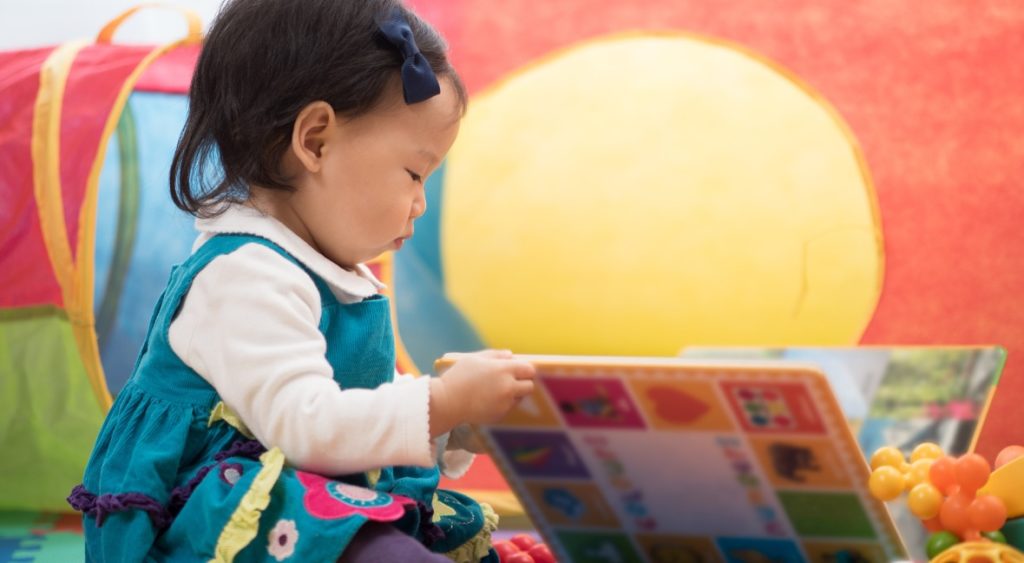
Examples of Fine Motor Skills by Age
0 – 3 months: moving hands, swiping at objects
3 – 6 months: inspecting hands, reaching for objects, reaching and grasping small toy, shaking a rattle
6 – 12 months: transferring an object from one hand to another, using pincher grasp (thumb and pointer) to pick up small objects, clapping, banging two objects together
12 – 18 months: turning a page in a book, pointing, placing shapes in puzzle, scribbling, stacking blocks
18 – 24 months: using utensils to self-feed, stacking 4 to 6 blocks, turning multiple pages in a book
2 years old: stringing beads, twisting lid on and off container, snipping with scissors
3 years old: dressing independently, completing puzzles with interlocking pieces, showing hand dominance
4 and 5 years old: cutting with scissors, drawing circle, cross, square, holding pencil with tripod grasp, writing letters and numbers
6+ years old: tying shoelaces, opening containers/lunch box items, cutting around shapes
Why Are Fine Motor Skills Important?
Fine motor skills are essential for achieving independence in everyday life. They allow kids to perform critical tasks such as feeding themselves, dressing, and writing, which are not only vital for self-care but also for academic succes.
Want your child to write? Let them squeeze, mash, and mold lots of playdough to build the necessary hand muscles!
Fine motor skills are also closely tied to cognitive development. They often require understanding, problem-solving, and memory. For instance, when a child learns to write, they’re not only practicing how to hold a pencil and form letters but also exercising their brain to recall information and express it clearly.
Developing Fine Motor Skills
Developing fine motor skills can be a fun and engaging process for kids.
Here are some activities and tips to encourage the growth of these skills:
- Artistic Activities: Drawing, coloring, painting, pinching stickers and tape, and sculpting with playdough can strengthen hand muscles and improve coordination. Avoid craft projects in favor of process art, where kids can use the materials as they would like.
- Manipulatives: Activities that require pinching, latching, or beading can enhance dexterity and hand-eye coordination. Toy examples: beading, puzzles, loose parts
- Daily Living Tasks: Encourage kids to dress and feed themselves, use cutlery, and perform other self-care tasks that require fine motor control. This builds independence, self-esteem, and motor skills.
- Writing Exercises: Give kids access to pencils, markers, and crayons so they can practice lots of markmaking. With practice, kids gain control over writing instruments. Kids can begin “writing” even before they learn to form letters.
- Sensory Play: Activities like playing with sand, water, rice, or in a mud kitchen can also improve fine motor skills as kids scoop, pour, and pick up small items.
Fine motor skills are best developed through everyday life activities and child-led play.
For example, instead of trying to make your child sit and complete an adult-directed table activity with tongs, head to the blueberry farm. Kids develop their pincher grasp by picking hundreds of blueberries. Kids get much more practice because they are intrinsically motivated and engaged in the activity.
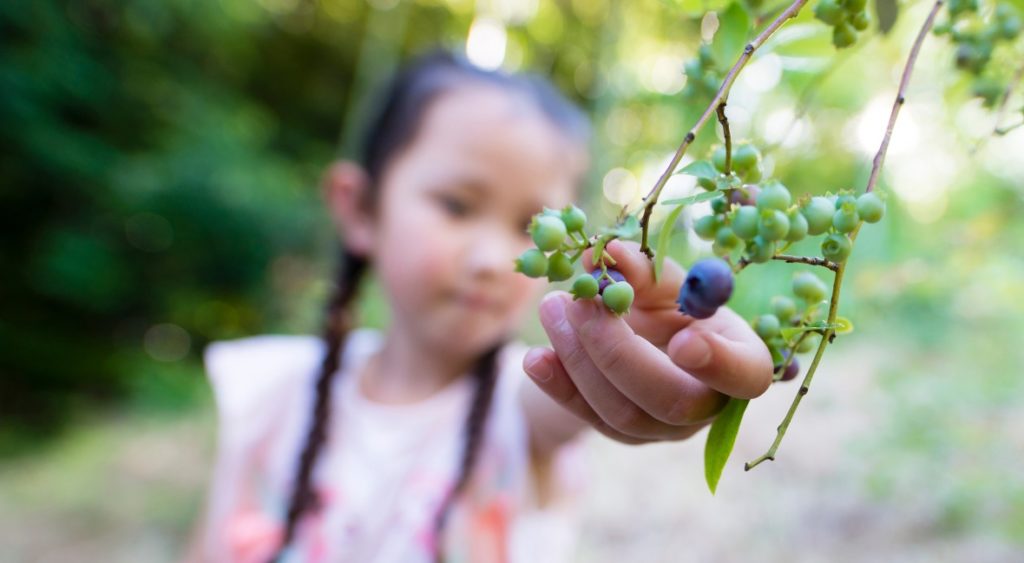
What Are Gross Motor Skills?
Gross motor skills are the abilities needed to control the large muscles of the body for walking, jumping, climbing, and other physical activities. These skills involve larger movements and are essential for mobility and stability.
Examples of gross motor skills include running, throwing a ball, biking, and swimming.
Examples of Gross Motor Skills By Age
0 – 3 months: lifting head, kicking feet
3 – 6 months: rolling over, bearing weight when held up
6 – 12 months: crawling on belly, sitting independently, pulling up to standing
12 – 18 months: walking, kicking ball
18 – 24 months: moving to music, bending to pick up a fallen toy
2 years old: running, walking up and down steps
3 years old: climbing ladders, pedaling a tricycle, jumping, throwing, catching
4 and 5 years old: hopping on one foot, skipping
6+ years old: running around obstacles, walking backward, swimming, riding a bike
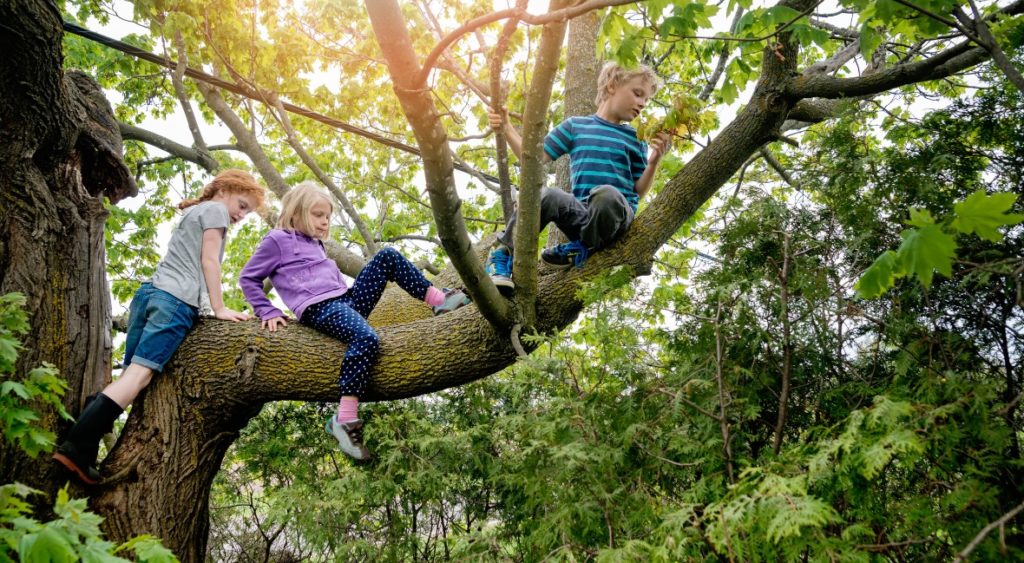
Why Are Gross Motor Skills Important?
Gross motor skills are fundamental to your child’s physical development and overall well-being. They form the core abilities that allow for basic movements like standing, walking, running, and jumping. These skills are the foundation for more complex movements and are crucial in building your child’s confidence and self-efficacy in their physical abilities.
Gross motor skills also play a significant role in your child’s health. They encourage kids to be active, contributing to the development of a healthy cardiovascular system, strong muscles, and good coordination.
These skills facilitate participation in active play with peers, which are vital for social-emotional development, teamwork, and learning how to navigate success and failure in a low-stakes environment.
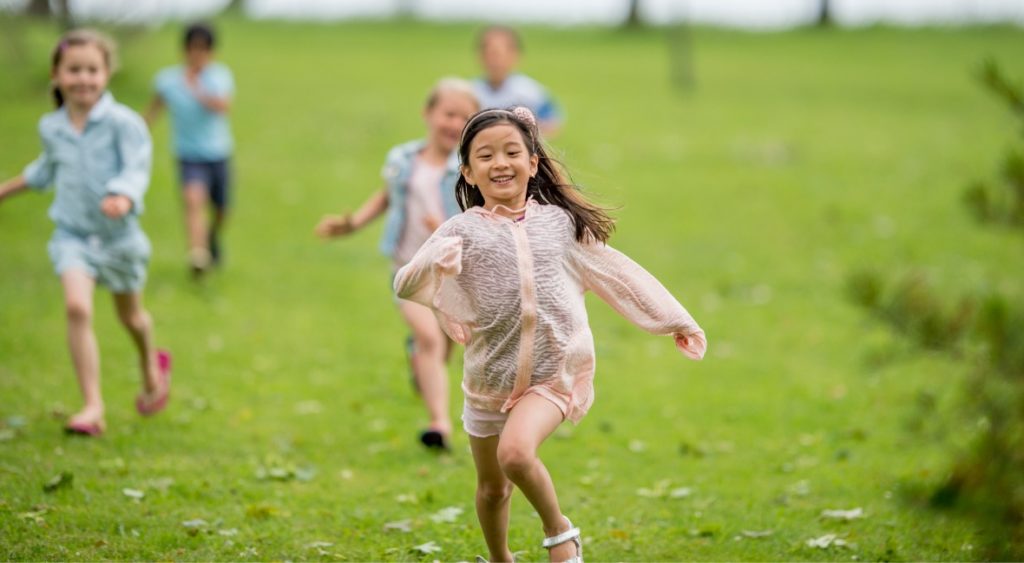
They are also associated with cognitive development. Physical activities that require gross motor skills, such as navigating playground equipment or participating in sports, engage your child’s problem-solving skills and spatial awareness.
Finally, gross motor skills support fine motor skills. Your child must have a stable core and good balance to effectively use their fine motor skills for tasks like writing or cutting with scissors. It is not until kids are strong and coordinated that they can sit at a desk and do table work without fatigue.
Developing Gross Motor Skills
Improving gross motor skills often involves larger-scale movements and can incorporate various forms of play and exercise.
Here are several ways to support the development of these skills:
- Play: Allow for lots and lots of unstructured play starting when kids are babies! Give kids time everyday day to pick activities. Kids love to move, and this will build their large muscle groups.
- Sports: Participating in sports like soccer, basketball, or gymnastics can improve strength, coordination, and endurance. But avoid over-scheduling – limit adult-directed activities!
- Outdoor Exploration: Let kids play outside! When given unstructured time, kids will naturally move and play games such as tag, hide-and-seek, or hopscotch with their peers. Climbing on an outdoor climber, running, or playing in the park can help develop balance and spatial awareness.
- Dance and Movement: Music and movement activities, such as dancing or action songs, enhance rhythmic movement and motor planning.
- Obstacle Courses: Creating obstacle courses that require crawling, jumping, and balancing can be a fun way to build gross motor abilities.
Give kids places both indoors and outdoors where they can move and build their gross motor skills. When kids have spaces in the house for big body movements, behavior problems may diminish.
The Interplay Between Fine and Gross Motor Skills
While fine and gross motor skills are distinct categories, they are interconnected. For your child to effectively engage in fine motor activities, they often need the postural stability and control that gross motor skills provide.
For instance, a child needs to have good core strength and balance (gross motor skills) to sit upright and use their hands and fingers (fine motor skills) to write neatly.
Similarly, fine motor skills can influence the development of gross motor skills. Activities that require precise hand-eye coordination, such as catching or hitting a ball, depend on fine motor control to execute the task accurately.
Supporting Holistic Development
Recognizing the difference between fine motor and gross motor skills is only part of the equation. It’s also vital to provide opportunities that foster the development of both skill sets. This can be achieved through a mix of a well-resourced environment and free play.
It’s important to create an environment that challenges and encourages kids to explore and refine their abilities while also ensuring that they have fun and stay motivated.
Parents and educators can play an active role by providing the necessary tools and space for kids to move and explore. Additionally, monitoring developmental milestones can help identify areas where your child may need extra support or intervention.
When to Seek Professional Help
If you have concerns about your child’s motor skill development, it’s crucial to consult with your pediatrician. They can provide assessments, advice, and interventions to support your child.
I recommend using the CDC Milestones App to track your child’s developmental milestones from age 2 months to 5 years. The app asks simple questions and gives examples so that you can track progress in social/emotional, language/communication, cognitive, and movement/physical development. It also offers tips and activities to support development.
If your child doesn’t meet one or more milestones for their age, you’re advised to chat with your doctor, and the checklist gives you the language to discuss your concerns. For example, instead of saying, “Something just seems a bit off,” you could say, ” I completed the 18-month-old milestones checklist for Sophie, and she is unable to feed herself with her fingers.”
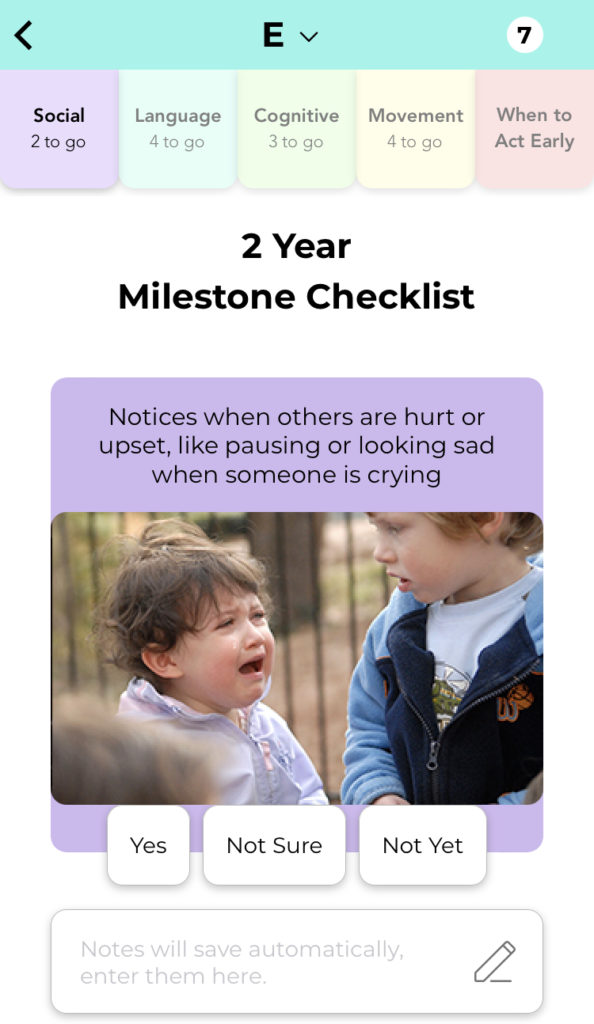
Final Thoughts
Understanding the difference between fine motor and gross motor skills is essential for supporting your child’s development. These skills are the building blocks for independence, learning, and healthy physical and cognitive development.
By providing kids with various opportunities to enhance their fine and gross motor abilities, we can set them up for success in numerous facets of their lives.
Let’s give kids the time and space to climb, jump, draw, and explore their world! It’s these everyday play experiences that give them the skills they need to thrive and grow.


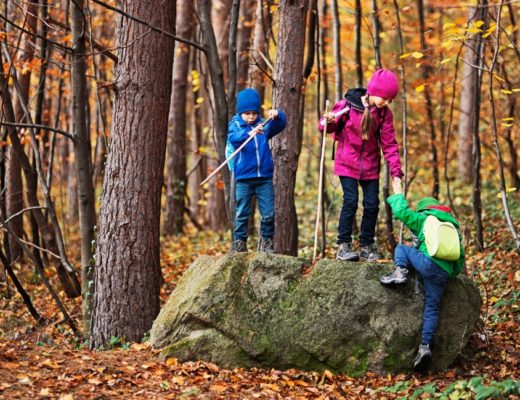
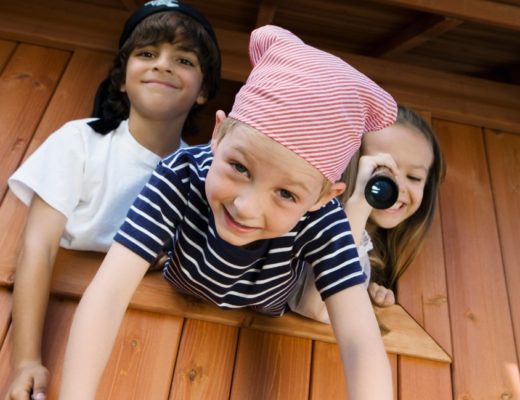
No Comments